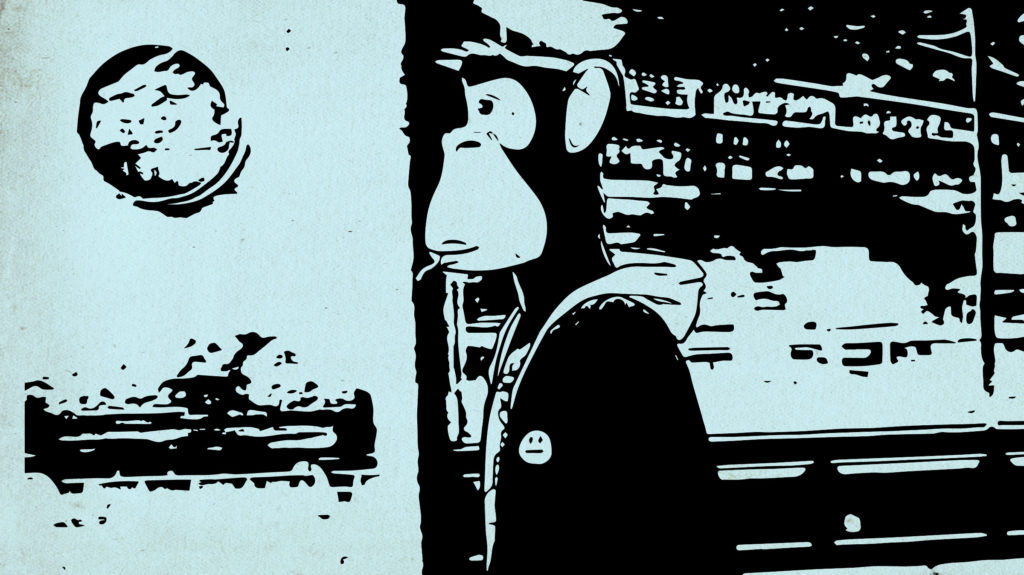Above the Fold
Read time
Text by
Illustration by
The failure of Seth Green’s ‘White Horse Tavern,’ starring a Bored Ape NFT, exemplified the risks of pairing investment with media creation
Any number of crises can derail a TV production—actors might pull out at the last minute, accidents can happen on set, or an overly ambitious concept could deplete the budget. But Seth Green’s latest project, White Horse Tavern, could be stymied by an unprecedented type of disaster: The show’s main character has literally been stolen.
White Horse Tavern would have been the latest in a string of NFT-based web and streaming shows. Part-marketing vehicle, part-genuine attempt at scripted comedy, the show’s trailer depicts animated characters—all of whom are NFTs from Green’s collection—bandying about New York City Roger Rabbit-style, alongside a live-action human cast. Green’s “Bored Ape,” Fred Simian, is the bartender at the titular tavern.
In May, Green tweeted that the Fred Simian token was stolen in a phishing scam and subsequently sold to a collector known as “DarkWing84” for more than $200,000. According to reporting from BuzzFeed News, the former owner of a stolen NFT lacks legal protection once the token is resold—DarkWing84 now likely controls the rights to the character’s licensing, including for White Horse Tavern.
But the incident raises greater questions than those surrounding the mere theft of Fred Simian. Animated series have emerged as an answer to the fundamental dilemma of what, if anything, an NFT does, and Green is just one of numerous high-profile celebrities pushing animated series funded by and centering NFTs. Unlike a traditional film or TV show, in which characters are just one component of the studio’s intellectual property, each NFT character in White Horse Tavern technically belongs to Seth Green and could be resold on the NFT market. Proponents of the format argue that it returns control to the show’s creators by removing the major networks as middlemen, and directly engages audiences with the production of the media they enjoy. But Green’s predicament reveals a major vulnerability of NFT-based production—and it’s far from the only red flag.
“Seth Green’s latest project, White Horse Tavern, could be stymied by an unprecedented type of disaster: The show’s main character has literally been stolen.”
Judging from the slate of shows produced under the model so far, NFT integration isn’t immediately fostering the next wave of prestige entertainment. The most widely viewed NFT show, The Red Ape Family—an Emerati production on which 2 Chainz is an executive producer—is available for streaming on YouTube and Apple TV+. Like with White Horse Tavern, the characters are privately held Bored Ape NFTs. Watching the show, it’s clear that the creators prioritized raising the NFTs’ platforms over making quality entertainment—the jokes are lazy, the animation is choppy, and the two episodes released over the past six months lack any comprehensible plot. The show’s writer, Chris Goward, was fairly transparent about the team’s motivations in a statement to the NFT blog Bored Ape Gazette. “We didn’t just want to hold [Bored Ape] NFTs and watch them appreciate in value,” he explained. “NFT projects, on the whole, lacked innovation and true utility.” In other words, NFTs needed a purpose, and Goward saw an opportunity to profit from the characters not just as collectors’ items, but as intellectual properties. He’s essentially saying the quiet part out loud: The Red Ape Family is an investment vehicle as much as it is an entertainment venture.
While The Red Ape Family seems intent on reaching a wide audience, the same cannot be said for other NFT-based shows. Stoner Cats, a Mila Kunis-backed series starring Jane Fonda, Chris Rock, and Seth MacFarlane, is exclusively available to owners of tokens created by the show, which currently cost between $290 and $500. On the low end, accessing the five-minute shorts costs more than twice the price of an annual Netflix subscription—clearly, the animated series is not the main product for sale. But that didn’t stop investors from buying the entire set of NFTs in 35 minutes, generating $8.3 million in revenue for Kunis’s production company.
“We can expect to see more productions in which boosting the tokens comes first, and quality is essentially an afterthought.”
To justify the price of admission, Stoner Cats offers investors opportunities for “co-creation”—they can purchase “sponsorship NFTs,” which the show’s website describes as “product placement but for the everyman,” and vote on forthcoming plot direction in the series. (In case there was any confusion, the website clarifies that “this is not design/writing by committee.”) In some ways, Stoner Cats is more like a private performance than a television show; the NFT-holders are like patrons of a bizarre, invitation-only play, rewarded for their support with the ability to cast their vote for the protagonist’s fate in the following installment.
The Red Ape Family’s appeal to a mass audience and Stoner Cats’s members-only approach share the same core purpose: to add utility to functionless aesthetic properties. Crucially, making a great “piece of entertainment” (as Kunis puts it) is not the sole objective of either project.
Whether White Horse Tavern would have involved co-creation, remained exclusive to token holders, or offered other perks for crypto bros remains unknown. But centering the show on NFTs was clearly an investment decision on Green’s part: By bringing more eyes to his apes, he hoped to raise their value. As with any investment decision, the endeavor involved a level of risk; in this case, part of Green’s gamble was the possibility of a thief hijacking the show’s core intellectual property. It’s entirely possible that the entire model of NFT-based funding could fizzle in the coming months, with the market already plummeting from 2021’s heights. But if proponents like Green and Kunis are right, and shows featuring privately-owned NFT characters become the norm, we can expect to see more productions in which boosting the tokens comes first, and quality is essentially an afterthought.
Author
Administraroot


